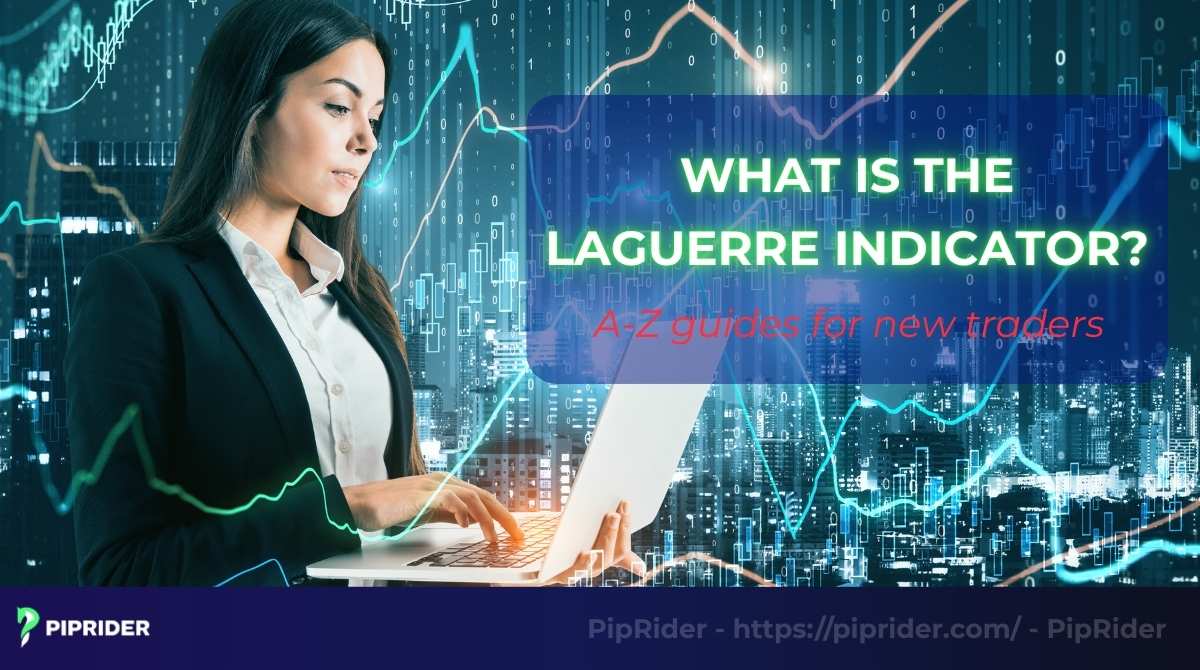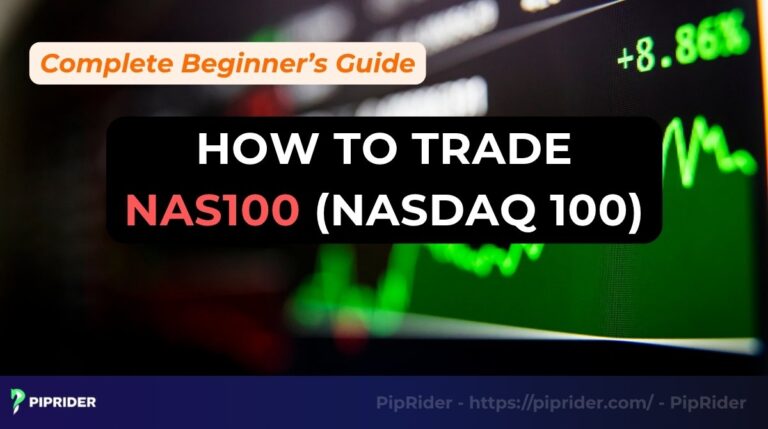If you’re tired of the endless cycle of false signals from classic indicators like the RSI, where the line seems to lag just enough for you to miss the perfect entry, you’ve come to the right place. Many traders feel that frustration, wondering if there’s a tool out there that’s both faster and smarter.
This is where you stumble upon the Laguerre Indicator. It’s not as famous as its cousins, the Relative Strength Index or MACD, which is precisely why it’s so intriguing. It’s a tool that many experienced traders quietly add to their charts, often replacing the RSI entirely. But why? What makes it different?
Piprider’s guide cuts through the hype. We are going to show you exactly what the Laguerre is, how its unique calculation helps it filter market noise, and how to apply it with practical, rule-based strategies. There’s no magic bullet here, but by the end, you’ll understand why this indicator has earned a hidden-gem reputation among those in the know.
Key Takeaways
- The Laguerre Indicator uses a special Laguerre filter with a “gamma coefficient”, resulting in a smoother and often faster-reacting line than the traditional RSI.
- Its primary strength is in identifying market cycle turning points with minimal delay, making it excellent for catching potential reversals early.
- It is best used for crossover signals (e.g., crossing the 0.15 or 0.75 levels) but only when combined with a primary trend indicator like a moving average.
- The ‘gamma’ setting is crucial; using the wrong value can completely change the indicator’s behavior. It is not a “set and forget” tool.
1. What is the Laguerre Indicator?
The Laguerre Indicator is a technical analysis tool, most commonly known as a modified version of the Relative Strength Index (RSI). Developed by John Ehlers, it uses a Laguerre transform to smooth price movements. This helps filter out market noise and provides clearer, more responsive trading signals with less lag than traditional indicators.

- A quick comparison with RSI: While the classic RSI can often look jagged and give choppy signals in volatile markets, the Laguerre’s line appears much cleaner and more decisive. It’s designed to react quickly to price movements without erratic behavior.
- Who is it for? This indicator is perfect for the trader who understands the basics but wants to “upgrade” from the RSI. It’s for those who need a tool that responds quickly to the market cycle while smoothing out insignificant price noise.
So, why do so many day traders and scalpers quietly replace the classic RSI with this indicator? Because in the right hands, it can offer a significant edge in timing entry points and exit points. Let’s dive into how it works.
2. How the Laguerre indicator actually works
Let’s pull back the curtain. The reason the Laguerre indicator feels so different isn’t magic; it’s just clever math. But don’t worry, you don’t need a degree in engineering to understand it. We’ll break it down simply.
At its heart, the indicator uses a special type of filter, almost like a pair of noise-canceling headphones for market data. This allows it to smooth out the insignificant jitters in price while still reacting incredibly fast to the price movements that actually matter.
This is why it solves a common frustration: most indicators are either fast and choppy or smooth and slow. The Laguerre aims to be the best of both worlds.
2.1. The “gamma” parameter: Your most important setting
Here’s where things get interesting and where you take control. The indicator’s behavior is almost entirely controlled by one setting: gamma. Think of gamma as a sensitivity dial. Understanding this dial is the key to making the indicator work for you.
- A low gamma (like 0.2 or 0.3): This makes the indicator extremely sensitive and fast. The line will be jagged and react to every tiny price move. Frankly, for most traders, this setting is too chaotic and can feel like trying to read a seismograph during an earthquake.
- A high gamma (like 0.7 or 0.8): This makes the indicator very smooth and slower. The line will look more like a gentle, flowing wave, ignoring minor noise and only reacting to more significant market cycle. This is often the starting point for swing traders.
There is no “best” setting. It completely depends on your trading style and the market you’re analyzing.
2.2. The signal line and its zones
The indicator produces a single line that oscillates between 0 and 1. The key zones are generally fixed:
- Overbought Zone: The area above 0.75.
- Oversold Zone: The area below 0.15.
Now, here is a critical mistake many traders make: they treat these zones exactly like they treat the RSI’s 70/30 levels. This is very dangerous. With the Laguerre indicator, the line can enter the vùng quá mua and stay there for a long time during a strong uptrend. Selling just because it crossed 0.75 is a recipe for getting run over by the trend.
The real signal is not when the line enters the zone, but when the line decisively exits. A move from above 0.75 back down across this level is a much more reliable sell signal. The inverse of this logic applies to the overbought.
Read more:
Technical Indicators List: 25 Tools Every Trader Must Know
Supertrend Indicator: Definition, Formula, Proven Strategies
3. How to install the Laguerre indicator on TradingView and MT4
The Laguerre is a bit of a hidden gem, as most platforms don’t include it as a default tool. You’ll need to add it yourself, but don’t worry, the process is straightforward, and Piprider will show you how for both TradingView and MT4.
3.1. Setting Laguerre on TradingView
TradingView has a huge library of custom indicators built by its community, which makes adding them very easy.

- To begin, locate the ‘Indicators’ button in the toolbar at the top of your chart.
- In the pop-up window, navigate to the ‘Community Scripts’ tab.
- In the search bar, type in “Laguerre RSI”. You will see a few different versions.
- Our advice here is to choose one with a high number of likes and a reputable author. A widely used version will often have a title like “Laguerre RSI [Ehlers]” to acknowledge the creator.
- Simply click on it, and it will instantly appear on your chart.
3.2. Setting Laguerre indicator on MetaTrader 4 (MT4)
For MT4, the process is a little more manual but still simple if you follow these steps carefully.
- Find a reliable source. The first step is to download the indicator file (usually an .ex4 or .mq4 file). The official MQL5 community website is generally a safe place to look. We have to give a serious warning here: never, ever download indicator files from a random, untrusted website, especially if they promise guaranteed profits. It’s a huge security risk.
- Open your data folder. Inside your MT4 platform, click on File in the top-left corner, and then select Open Data Folder.
- Find the right folder. A window will pop up showing MT4’s files. Navigate into the MQL4 folder, and then click into the Indicators folder.
- Add the indicator. Move the indicator file you just downloaded into this Indicators folder.
- Refresh. Close and reopen MT4, or go to your “Navigator” window, right-click on “Indicators”, and hit “Refresh”. The Laguerre will now appear in your list, ready to be used.
3.3. Adjusting the settings
After the indicator appears on your chart, you can begin to adjust its settings. You’ll see a small ‘settings’ gear icon when you hover over the indicator’s name. Here are suggestions for the parameters:
- For smoothing trend following (default): We usually start with a gamma of 0.7. This gives a clean, flowing line that’s excellent for swing trading on H1 or H4 charts.
- For fast signals (scalping): If you are trading on much lower timeframes and need a faster reaction, you could experiment with a gamma around 0.3 to 0.5. Be warned, this will produce far more signals, and many will be noise.
You can also change the colors of the line and adjust the 0.15 and 0.75 level lines to make them more visible. We like to make the crossover line a bit thicker so our eyes can catch the signals easily.
4. The strengths and weaknesses of the Laguerre indicator
Let’s be perfectly honest: there is no such thing as a “holy grail” indicator, and the Laguerre is no different. While this indicator has some incredible strengths, it also has weaknesses that can hurt you if ignored. Knowing its strengths and weaknesses is crucial for using the tool properly.
4.1. The strengths
When you apply the Laguerre correctly, it offers some compelling strengths that can really clean up your analysis.
- Exceptional noise reduction: Thanks to its underlying filter, it smooths out the chaotic price jitters that often plague standard indicators, leading to a cleaner line and less emotional second-guessing.
- Early and low-lag signals: Because of its low-lag design, the Laguerre can signal a potential shift in momentum before many other oscillators.
- Effortless strategy integration: As a single line that doesn’t clutter your chart, it’s incredibly easy to pair with existing tools like moving averages or trendlines for confirmation signals.
4.2. The weaknesses
No tool is perfect, and ignoring this indicator’s weaknesses can be a costly mistake.
- Unsuitability for sideways markets: When the market is chopping back and forth with no clear direction, the Laguerre line will often hover aimlessly, and trying to find a signal is a waste of time.
- Risk of unreliable trading signals when used alone: This is the most dangerous trap. Because it’s so responsive, the Laguerre can sometimes signal a reversal that never actually happens, which is why you must use it as part of a system.
Piprider’s recommendations:
- Use it on the H1 timeframe or higher. We strongly advise against using this indicator on very low timeframes like M1 or M5. The amount of market noise can overwhelm even a good filter, leading to a stream of unreliable signals and whipsaws.
- Use it as a signal filter, not an entry trigger. This is a hard-earned lesson. The best way to use the Laguerre is as your final confirmation check. It answers the question, “Does the market’s strength agree with our trade idea?” It should not be the primary reason you enter a trade.
5. Trading strategies with the Laguerre indicator
An indicator is only as good as the strategy built around it. The next step is to put this tool into a rule-based system.
This section will demonstrate two distinct ways to use the Laguerre for finding entries. It is important to note that these are not “get rich quick” formulas; they are disciplined frameworks for trading.
5.1. Strategy 1: The EMA trend filter
The EMA trend filter strategy is a simple, robust system that ensures you are always trading with the main trend, using the Laguerre to time your entry.
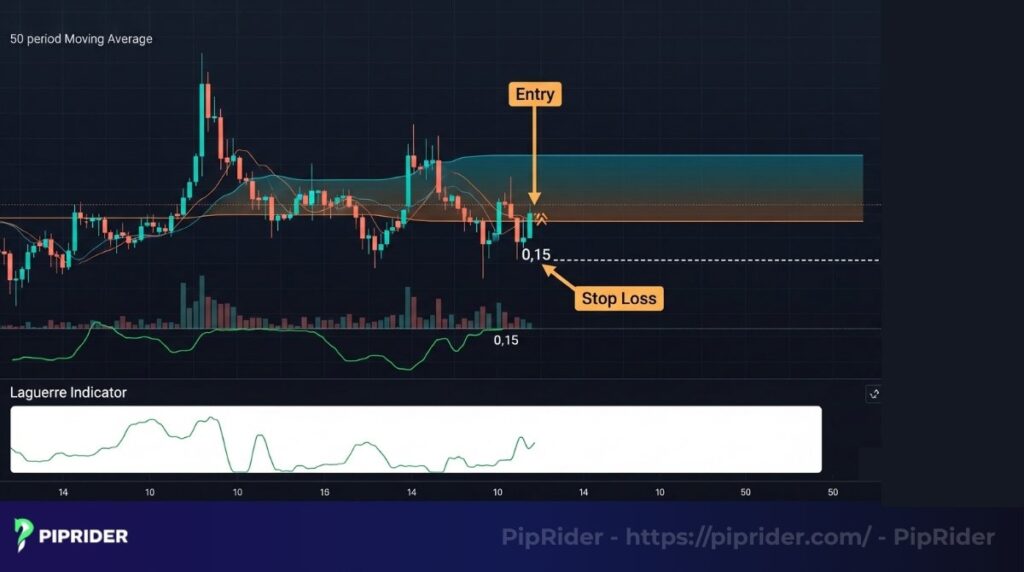
The logic: This strategy uses a longer-term moving average (like the 50 EMA) as our “trend director”. If the price is above it, we are only looking for buys. If it’s below, we only look for sells. The Laguerre indicator then acts as our entry trigger, helping us buy the dips in an uptrend or sell the rallies in a downtrend.
The rules for a buy trade:
- Trend filter: The price must be trading above the 50 EMA, and the EMA itself should be clearly sloping upwards. This is a non-negotiable rule.
- Find the dip: Wait for the Laguerre line to drop into the overbought (oversold zone) (below the 0.15 level). This signals a temporary pullback or exhaustion.
- The entry trigger: The signal is not when it enters the zone, but when it crosses back up above the 0.15 line. This is your confirmation that buying strength is likely resuming.
- Stop loss: A logical place for your stop loss is just below the most recent price swing that formed during the pullback.
- Take profit: You could target a fixed risk-to-reward ratio (e.g., 1:1.5 or 1:2) or hold the trade until the Laguerre line reaches the overbought zone (above 0.75).
5.2. Strategy 2: The Laguerre divergence
The Laguerre divergence is a more advanced reversal strategy. It’s designed to spot when a trend is running out of steam and is potentially about to reverse.
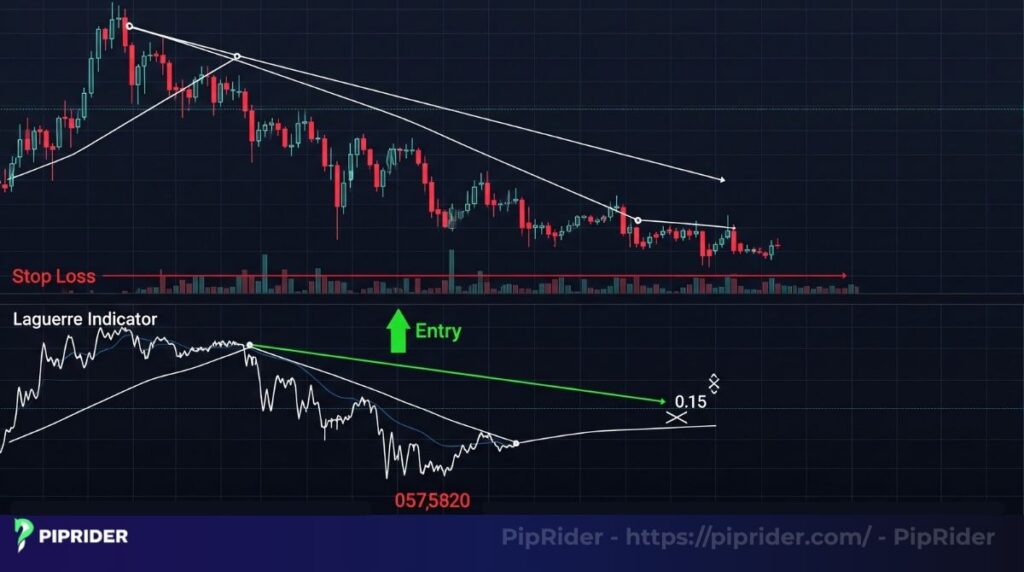
The logic: Divergence occurs when there is a mismatch between price action and the indicator. This conflict is a classic signal that the current trend is losing strength. We use the Laguerre to spot this subtle shift in strength.
The rules for a bullish divergence (a buy signal):
- Identify the divergence: Find a point where the price on your chart forms a new lower low, while the Laguerre indicator simultaneously forms a higher low. This indicates that the selling pressure was fading, even as the price itself dropped.
- The entry trigger: Wait for the Laguerre line to start moving up and, ideally, cross above the 0.15 or 0.2 level to confirm that buying pressure is starting to build.
- Stop loss: Place your stop loss just below the absolute lowest point of the price low. If the price breaks this level, the divergence signal is invalid.
A quick tip for backtesting:
The only way to build real trust in a strategy is by testing it. Don’t just look at past charts. Use the Bar Replay tool on TradingView. Go back in time, hit the “play” button, and let the chart move forward one candle at a time.
Make your trading decisions as if it were live and be brutally honest with your results. This is the closest you can get to live trading without risking real money.
6. Laguerre vs. RSI: Which one should you use?
When comparing the old, reliable RSI with the newer Laguerre indicator, the question isn’t “Is one truly better?” A more useful question is, “Which tool is the right one for a specific task?”
Each indicator has distinct characteristics and is suited for different market conditions.
A quick head-to-head comparison:
| Feature | The Classic RSI | The Laguerre |
| Reactivity | Standard | Faster, more responsive |
| Noise Level | Higher | Lower and smoother |
| Installation | Built-in by default | Manual add-on (community script) |
6.1. When should you consider using the Laguerre indicator?
The Laguerre is most effective in the following scenarios:
- When the market is in a clear, trending phase. The smooth nature of the Laguerre line is a significant benefit in this scenario. It helps you stay in a strong trend without getting shaken out by the minor pullbacks that can make the RSI look choppy and confusing.
- When your goal is to get an earlier warning of a potential reversal. The indicator’s low-lag design allows it to provide a subtle hint that the trend is changing, sometimes well before the RSI catches on. This can be invaluable, but the feature comes with a risk that requires strict confirmation.
6.2. Why is the RSI still a valuable tool?
This doesn’t mean you should abandon the RSI entirely. It’s a classic for a reason and continues to be a top performer in specific situations:
- When the market is consolidating within a clear range. In a choppy, non-trending market, the classic 70/30 overbought levels of the RSI can sometimes provide clearer and more reliable signals for mean-reversion trades.
- When you are looking for powerful divergences. Since so many traders watch the RSI, its divergence signals can almost become a self-fulfilling prophecy. A strong, clean divergence on the RSI often carries more weight in the market simply because so many people see it and act on it.
7. Important notes and practical experience
Theory and strategies provide the foundation, but real-world trading presents different challenges. This section details the small, crucial insights learned from years of applying this indicator, practical tips that can save traders significant time and money.
7.1. The most common mistakes
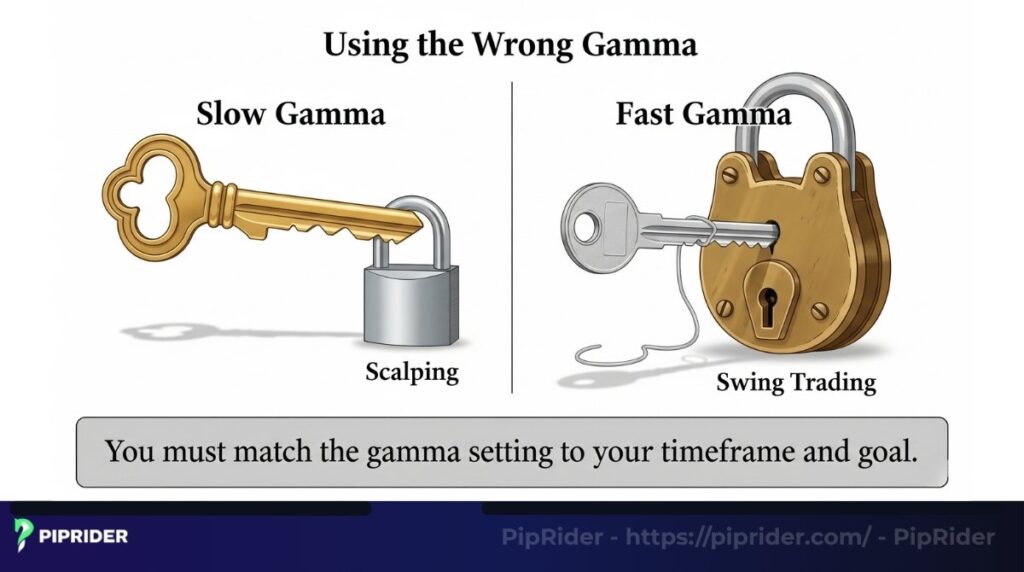
There are two common mistakes when using Laguerre indicator:
- Using the wrong gamma for your style: This is the number one error. A day trader using a fast gamma of 0.3 will be driven crazy by unreliable signals. A trader using a slow gamma of 0.8 will miss every move. You must match the gamma setting to your timeframe and goal. Don’t just copy a setting you saw somewhere; test it and see if it makes sense to you.
- Ignoring the primary trend: A trader sees the Laguerre cross up from its overbought and jumps into a buy, completely ignoring that the price is in a massive downtrend below every major average. This is like checking the wind speed without looking at the direction of the hurricane. The primary trend will almost always win.
7.2. Wisdom from the trading community
After seeing countless charts and talking with other traders, a few key themes always emerge about this indicator.
- It works best in long, steady trends: While it can spot reversals, its true strength is in helping you navigate those long, drawn-out trends where the price grinds up or down for days. The smoothness of the Laguerre line helps you stay patient and not get shaken out by minor corrections.
- It becomes incredibly powerful with price action: A Laguerre signal on its own is just an idea. But a Laguerre crossover that happens immediately after a bullish engulfing candle forms at a key support level? That’s a high-probability setup. Always look for price action to confirm what the indicator is suggesting.
- Consider multi-timeframe analysis: Using the Laguerre on a higher timeframe can help you determine the overall trend direction, while a lower timeframe can be used for precise entry timing.
7.3. A final, crucial warning
If there is only one thing you take away from this guide, let it be this: do not become dependent on this or any other indicator. Its purpose is to assist your brain, not replace it.
The market is always changing. A setting that works today might not work tomorrow. But if you understand the principle behind the tool, that it’s a low-lag filter designed to track the market cycle, you can adapt your thinking. A trader who understands the why will always beat a trader who is just blindly following a line on a screen.
8. FAQs
Here are some quick, no-nonsense answers to the most common questions traders ask about this unique indicator.
9. Conclusion
So, is the Laguerre indicator worth a spot on your charts? Our answer is yes, but with one critical condition. While this indicator’s ability to smooth noise and give early signals is impressive, it should be used to confirm your existing strategy, not replace it.
We strongly recommend you experiment with this tool as a signal filter to see if it improves your timing and confidence. Your next steps are simple: backtest a strategy that fits your style, then learn how complementary tools like Volume or the ATR can provide that final layer of confirmation.
To continue building your technical analysis toolkit, we invite you to explore more guides in the Learn Forex category, right here on Piprider.


